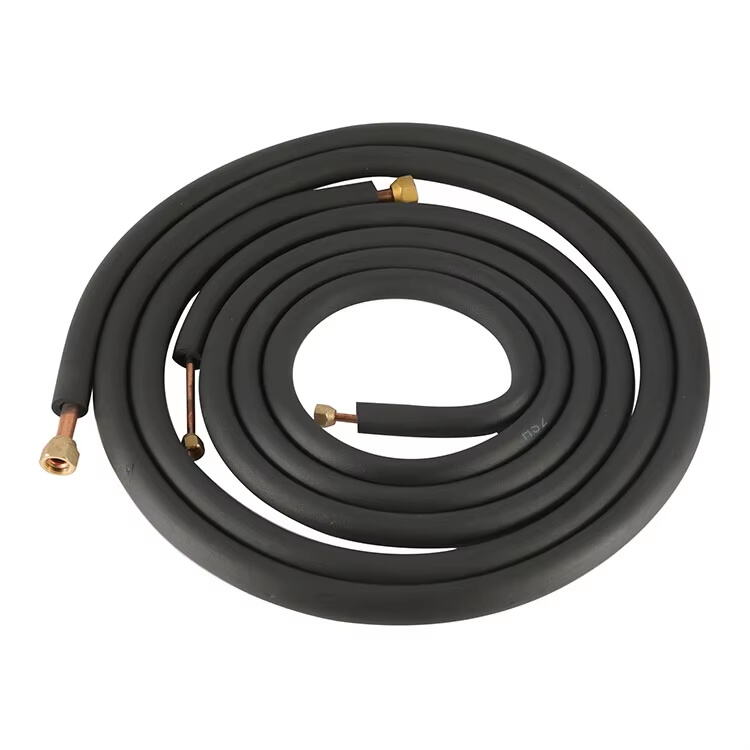အိုင်းဆူလေးတင် ကြေးဝါပိုက်စနစ်၏ စွမ်းအင်ခြွေတာနိုင်မှုကို နားလည်ခြင်း
ယနေ့ခေတ်တွင် စွမ်းအင်လိုအပ်ချက်များ တဖြည်းဖြည်းများပြားလာခြင်းနှင့် ပတ်ဝန်းကျင်ဆိုင်ရာ သတိထားမှုများ တိုးတက်လာခြင်းတို့ကြောင့် အဆောက်အဦစနစ်များတွင် စွမ်းအင်ထိရောက်စွာ အသုံးပြုနိုင်ရန် နည်းလမ်းများရှာဖွေတွေ့ရှိရေးသည် အလွန်အရေးကြီးလာပါသည်။ ဖောက်ထားသော PE အိုင်းဆူလေးရှင်းသည် ကပ်ပွင့်ပံ ပိုက်ဆက်ဆိုင်ရာနှင့် HVAC နည်းပညာတွင် အဆင့်မြင့်တက်လာမှုကို ကိုယ်စားပြုပြီး အပူချိန်ကာကွယ်ပေးခြင်းနှင့် စွမ်းအင်ခြွေတာမှုဆိုင်ရာ အကျိုးကျေးဇူးများကို ပေးစွမ်းပါသည်။ ဤစုစည်းထားသောလမ်းညွှန်ချက်သည် အိမ်တို့နှင့် စီးပွားရေးဆိုင်ရာ အသုံးပြုမှုများတွင် အပူချိန်တည်ငြိမ်မှုကို ထိန်းသိမ်းပေးခြင်းနှင့် စွမ်းအင်ဆုံးရှုံးမှုကို လျော့နည်းစေရန် ဤတီထွင်ထားသော ပိုက်စနစ်က မည်ကဲ့သို့အထောက်အကူဖြစ်စေသည်ကို စူးစမ်းလေ့လာပါသည်။
အရည်အသွေးမြင့် ကြေးဝါပိုက်နှင့် ဖြူသော ပေါလီအီသလင်း (PE) အိုင်းဆူလေးရှင်းဖြင့် ပေါင်းစပ်ထားခြင်းက အပူချိန်ပြောင်းလဲမှုနှင့် စွမ်းအင်ဆုံးရှုံးမှုကို ထိရောက်စွာ လျော့နည်းစေသော စနစ်တစ်ခုကို ဖန်တီးပေးပါသည်။ ပူသောရေဖိအားစနစ်၊ လေအေးပေးစနစ် သို့မဟုတ် အပူပေးစနစ်များတွင် အသုံးပြုသည်ဖြစ်စေ ဤအိုင်းဆူလေးတင်ပိုက်များသည် အပူချိန်ထိန်းချုပ်မှုကို တည်ငြိမ်စေပြီး လည်ပတ်မှုစရိတ်ကို လျော့နည်းစေရာတွင် အဓိက အခန်းကဏ္ဍမှ ပါဝင်ပါသည်။
အပူချိန်အိုင်းဆူလေးရှင်းနည်းပညာကို ရှုပ်ထွေးသော သိပ္ပံပညာ
ပစ္စည်းဖွဲ့စည်းမှုနှင့် ဂုဏ်သတ္တိများ
အဖြူရောင် PE အြခားထားသည့် ကြေးဝါပိုက်စနစ်များ၏ အကျိုးသက်ရှိသည့် ပစ္စည်းများကို တွဲဖက်အသုံးပြုခြင်းသည် အဓိကအချက်တစ်ခုဖြစ်ပါသည်။ ကြေးဝါပိုက်သည် အပူစီးကူးမှုကောင်းမွန်မှုနှင့် ခံနိုင်ရည်ရှိမှုတို့ကို ပေးစွမ်းပေးသည့်အပြင် အဖြူရောင် PE အြခားထားသည့် အလွှာသည် အပူကိုထိရောက်စွာ တားဆီးပေးသည့် အြခားထားသည့် အလွှာတစ်ခုဖြစ်ပါသည်။ ပေါလီအက်တီလင်းအြခားထားသည့် ပစ္စည်းသည် အောက်ထက်လေအိတ်ငယ်များကို ဖမ်းထားနိုင်သည့် ပိတ်ထားသည့်ဆဲလ်တည်ဆောက်ပုံကို ပေးစွမ်းပါသည်။ ထို့ကြောင့် ပိုက်နှင့် ၎င်း၏ဝန်းကျင်တို့ကြား အပူပြောင်းလဲမှုကို သက်သာစေပါသည်။
PE အြခားထားသည့် အဖြူရောင်သည် အလှအပအတွက်သာမက အပူရောင်ခြည်ကို ပြန်လည်ကာကွယ်ပေးခြင်းဖြင့် စနစ်၏ အပူစွမ်းဆောင်ရည်ကို ပိုမိုတိုးတက်စေရန် အကျိုးသက်ရှိသည့် ရည်ရွယ်ချက်ကိုလည်း ပေးစွမ်းပါသည်။ ဤအထူးပြုလုပ်ထားသည့် အလ пок်သည် ပိုက်အတွင်းရှိ အပူချိန်ကို တည်ငြိမ်စေပြီး ပြင်ပအပူချိန် ပြောင်းလဲမှုများ၏ သက်ရောက်မှုကို လျော့နည်းစေပါသည်။
အပူစွမ်းဆောင်ရည် ညွှန်းကိန်းများ
အဖြူရောင် PE တွင် ကော်ပါးပြွန်၏ အပူစီးကူးမှုကို W/(m·K) ဖြင့် တိုင်းတာပြီး တန်ဖိုးနိမ့်နိမ့်သည် ပိုကောင်းသော အပူခံနိုင်သည့်ဂုဏ်သတ္တိကို ညွှန်ပြသည်။ ခေတ်မှ PE အပူခံပစ္စည်းများသည် အပူလွှဲပြောင်းမှုကို ခုခံနိုင်သော R-တန်ဖိုးများကို ပေးဆောင်လေ့ရှိသည်။ ဤအပူခံနိုင်သည့် စွမ်းရည်မြင့်မားမှုကြောင့် ပူသောရေသည် ပူနေပြီး အအေးရေသည် အအေးရှိနေသည်ကို သေချာစေပြီး ဆန္ဒရှိသော အပူချိန်ကို ထိန်းသိမ်းရန် လိုအပ်သော စွမ်းအင်ကို လျော့နည်းစေသည်။
ဓာတ်ခွဲခန်းစမ်းသပ်မှုများအရ အပူခံထားသော ကော်ပါးပြွန်များသည် အပူခံထားခြင်းမရှိသော ပြွန်များနှင့် နှိုင်းယှဉ်ပါက အပူဆုံးရှုံးမှုကို ၈၅% အထိ လျော့နည်းစေနိုင်သည်ကို တွေ့ရသည်။ အပူစွမ်းဆောင်ရည်တွင် ဤအဆင့်မြှင့်တင်မှုကြီးမားမှုသည် စွမ်းအင်ကို ခြွေတာမှုနှင့် စနစ်၏ စွမ်းဆောင်ရည်ကို တိုးတက်စေသည်။

တပ်ဆင်ခြင်းနှင့် စနစ်ပေါင်းစည်းမှုအကျိုးကျေးဇူးများ
ပြောင်းလဲသော တည်ဆောက်မှုအမြဲတိုး
အဖြူရောင် PE အီလက်ထရစ်ကြေးပြွန်များကိုတပ်ဆင်ခြင်းသည် ကုန်ဆောင်များနှင့် အဆောက်အဦးပိုင်ရှင်များအတွက် အကျိုးကျေးဇူးများစွာပေးစွမ်းပါသည်။ ကြိုတင်တပ်ဆင်ထားသောပြွန်များသည် တပ်ဆင်ရန်အဆင်ပြေစေပြီး လုပ်သားအားစုကိုချွေတာပေးကာ အီလက်ထရစ်ကာကွယ်မှုကို တစ်ခုတည်းဖြစ်စေပါသည်။ အဖြူရောင် PE အုပ်ထားသောအလ пок် နေရောင်ခြည်နှင့် ပတ်ဝန်းကျင်ဆိုင်ရာအချက်များကိုခုခံနိုင်ပြီး စနစ်၏သက်တမ်းအတွင်း ကာကွယ်မှုဂုဏ်သတ္တိများကိုထိန်းသိမ်းပေးပါသည်။
ပြွန်များကိုတပ်ဆင်သည့်အခါ PE အီလက်ထရစ်ကာကွယ်မှုသည် ထပ်တိုးကာကွယ်မှုကိုပေးစွမ်းပြီး ကြေးပြွန်၏သဘာဝကွေးညွှတ်နိုင်မှုကိုထိန်းသိမ်းထားပေးသောကြောင့် ပြွန်များကိုကျွမ်းကျင်သောတပ်ဆင်သူများက အဆင်ပြေမှုနှင့်တွေ့ရှိရပါသည်။ ဤပေါင်းစပ်မှုကြောင့် တပ်ဆင်မှုအချိန်ကိုလျော့နည်းစေပြီး တည်ဆောက်မှုလုပ်ငန်းစဉ်အတွင်း ပျက်စီးမှုဖြစ်နိုင်ခြေကိုလျော့နည်းစေပါသည်။
စနစ်ပေါင်းစည်းမှုနှင့် ကိုက်ညီမှု
ဖြူသော PE တွင် ထည့်ထားသော ကြေးနီပိုက်သည် တည်ဆောက်ပြီးသား ရေပိုက်စနစ်များနှင့် HVAC စနစ်များနှင့် ပြေပြစွာ ပေါင်းစပ်ပါသည်။ စံထားသော အရွယ်အစားများနှင့် ကမ္ဘာ့စံချိန်ချိန်ညီမှုတို့ကြောင့် အဆောက်အဦးသစ်များနှင့် ပြုပြင်ထိန်းသိမ်းရေးစီမံကိန်းများအတွက် အကောင်းဆုံးရွေးချယ်မှုဖြစ်ပါသည်။ ဆူးဆွဲမှုများနှင့် ပိုက်ဆက်ပစ္စည်းများတွင် အပူချိန်ကို ထိန်းသိမ်းထားနိုင်စေရန် အပူကာကွယ်မှုအလွှာကို ဆက်သွယ်မှုများအတွက် လွယ်ကူစွာ ဖြတ်တောက်နိုင်ပါသည်။
ဤပိုက်များသည် ခေတ်မှီ စွမ်းဆောင်ရည်မြင့် ဘိုလာများ၊ အပူပိုက်များနှင့် နေကြာအပူရေပေးစနစ်များနှင့်အတူ အထူးကောင်းမွန်စွာ အလုပ်လုပ်ပြီး စွမ်းရည်ခြွေတာသော နည်းပညာများ၏ စွမ်းဆောင်ရည်ကို အများဆုံးဖြစ်အောင် ကူညီပေးပါသည်။ အပူကာကွယ်မှု ဂုဏ်သတ္တိများကို တစ်ခုတည်းဖြစ်စေရန် စနစ်တစုံလုံးသည် အမြင့်ဆုံးစွမ်းဆောင်ရည်ဖြင့် လည်ပတ်ပါသည်။
ရှည်လျားသော အပူစွမ်းဆောင်ရည်ခြွေတာမှုနှင့် ပတ်ဝန်းကျင်သို့ သက်ရောက်မှု
စရိတ်လျော့နည်းမှု အကဲဖြတ်ခြင်း
အဆောက်အဦစနစ်များတွင် ဖြူရောင် PE တပ်ဆင်ထားသော ကြေးနီပြွန်များ အသုံးပြုခြင်းဖြင့် ရှည်လျားသော ကာလအတွင်း ကုန်ကျစရိတ်ကို သက်သာစေပါသည်။ အစောဆုံး တွက်ချက်မှုများအရ စွမ်းအင်ခြွေတာမှုများသည် တပ်ဆင်ကုန်ကျစရိတ်ကို နှစ်နှစ်မှ သုံးနှစ်အတွင်း ပြန်လည်ဖြည့်ဆည်းပေးနိုင်သည်ဟု တွေ့ရှိရပြီး အသုံးပြုမှုပုံစံများနှင့် တိုင်းတာသော စွမ်းအင်စျေးနှုန်းများပေါ်တွင် မူတည်ပါသည်။ ကြေးနီပြွန်များကို အပူချိန်ထိန်းသိမ်းထားသော စနစ်များသို့ အဆင့်မြှင့်ပြီးနောက် အဆောက်အဦပိုင်ရှင်များက အပူပေးခြင်းနှင့် အအေးပေးခြင်းစရိတ်များ ၂၀-၃၀% လျော့နည်းသွားခြင်းကို အစီရင်ခံကြပါသည်။
ကြေးနီပြွန်များနှင့် PE အပူချိန်ထိန်းပစ္စည်းတို့၏ ခံနိုင်ရည်ရှိမှုကြောင့် စွမ်းအင်ခြွေတာမှုများသည် ဆယ်စုနှစ်များစွာ ဆက်လက်ဖြစ်ပေါ်နေမည်ဖြစ်ပြီး အဆောက်အဦပိုင်ရှင်များအတွက် ရှည်လျားသောကာလအတွင်း စီးပွားဖြစ်စွာ ရင်းနှီးမြှုပ်နှံရန် အကျိုးရှိသော ရင်းနှီးမြှုပ်နှံမှုဖြစ်ပါသည်။ အပူချိန်ထိန်းပစ္စည်းအလွှာ၏ ကာကွယ်ပေးသော သဘောသဘာဝကြောင့် ပုံမှန်ထိန်းသိမ်းရေးစရိတ်များကိုလည်း လျော့နည်းစေပါသည်။
ပတ်ဝန်းကျင် အကျိုးကျေးဇူးများ
ဖြူသော PE အြန်းပေးထားသည့် ကြေးဝါပိုက်၏ ပတ်ဝန်းကျင်ဆိုင်ရာသက်ရောက်မှုမှာ စွမ်းအင်ခြွေတာမှုအပြင် ပိုမိုကျယ်ပြန့်ပါသည်။ စွမ်းအင်စားသုံးမှုကိုလျော့နည်းစေခြင်းဖြင့် ဤစနစ်များသည် အပူပေးခြင်းနှင့် အအေးပေးစက်များနှင့် သက်ဆိုင်သော ဂရင်ဟောက်စ်ဂက်စ်များ ထုတ်လုပ်မှုကို လျော့နည်းစေရန် ကူညီပေးပါသည်။ ကြေးဝါပိုက်မှာ အပြည့်အဝ ပြန်လည်အသုံးပြုနိုင်သည့် ပစ္စည်းဖြစ်ပြီး ခေတ်မှီ PE အြန်းပေးသည့် ပစ္စည်းများကို ပြန်လည်အသုံးပြုသည့် ပစ္စည်းများနှင့် တည်တံ့သော လုပ်ထုံးလုပ်နည်းများဖြင့် ထုတ်လုပ်လာနေပါသည်။
ဤအြန်းပေးထားသော ပိုက်စနစ်များကို အသုံးပြုသည့် အဆောက်အဦများသည် အစိမ်းရောင်အဆောက်အဦ အသိအမှတ်ပြုလက်မှတ်နှင့် စွမ်းအင်ထိရောက်တမ်းများအတွက် အရည်အချင်းပြည့်မီပါသည်။ ထို့ကြောင့် ပတ်ဝန်းကျင်နှင့် စီးပွားရေးတန်ဖိုးကို ပိုမိုတိုးတက်စေပါသည်။ ကာဗွန်ခြေရာလျော့နည်းခြင်းသည် ကမ္ဘာ့တည်တံ့ခိုင်မြဲရေးရည်မှန်းချက်များနှင့် ကော်ပိုရိတ်ပတ်ဝန်းကျင်ဆိုင်ရာ တာဝန်များနှင့် ကိုက်ညီပါသည်။
မှားမြင်မှုကို ပြုပြင်ရေးနှင့် လုပ်ဆောင်မှုကို ကူးသန်းခြင်း
ရှုံးရောင်း ခြင်း စီ略
ဖိုလီအိတ် (PE) အြခားထုပ်ပိုးထားသည့် ကြေးဝါပိုက်စနစ်၏ ထိရောက်မှုကို ထိန်းသိမ်းရန် အနည်းငယ်သော်လည်း ပုံမှန်ဂရုစိုက်မှုများ လိုအပ်ပါသည်။ အြခားထုပ်ပိုးမှုအလွှာသည် စေးထုပ်မှုနှင့် သံချေးတက်မှုမှ ကာကွယ်ပေးကာ စနစ်၏ သက်တမ်းကို ရှည်လျားစေပြီး စွမ်းအင်ခြွေတာမှုဂုဏ်သတ္တိများကို ထိန်းသိမ်းပေးပါသည်။ ပုံမှန်စစ်ဆေးမှုများတွင် ဆက်စပ်မှုများနှင့် ချိတ်ဆက်မှုများတွင် အြခားထုပ်ပိုးမှု၏ တစ်ခုတည်းဖြစ်မှုကို စစ်ဆေးရန် အလေးထားသင့်ပါသည်။
ပရော်ဖက်ရှင်နယ် ထိန်းသိမ်းရေးအဖွဲ့များသည် အြခားထုပ်ပိုးမှု၏ ပျက်စီးသော နေရာများကို လွယ်ကူစွာ စိစစ်နိုင်ပြီး ပြုပြင်နိုင်ပါသည်။ ထို့ကြောင့် စနစ်၏ အကောင်းဆုံးစွမ်းဆောင်ရည်ကို ဆက်လက်ထိန်းသိမ်းပေးနိုင်ပါသည်။ အြခားထုပ်ပိုးမှု၏ ဖြူဖြူရောင်သည် ပုံမှန်စစ်ဆေးမှုများအတွင်း ဖြစ်နိုင်ချေရှိသော ပြဿနာများကို အလွယ်တကူ စိစစ်နိုင်စေပြီး တိုက်ရိုက်ကြိုတင်ကာကွယ်သော ထိန်းသိမ်းမှုကို ခွင့်ပြုပေးပါသည်။
စွမ်းဆောင်ရည် စောင့်ကြည့်ခြင်းနှင့် အကောင်းဆုံးဖြစ်အောင်ပြုလုပ်ခြင်း
ခေတ်မှီ အဆောက်အဦးစီမံခန့်ခွဲမှုစနစ်များသည် အြခားထုပ်ပိုးထားသော ပိုက်လမ်းကြောင်းများ၏ စွမ်းဆောင်ရည်ကို စောင့်ကြည့်၍ အကောင်းဆုံးဖြစ်အောင်ပြုလုပ်ပေးနိုင်ပါသည်။ အပူချိန်ခြားနှိပ်ကိရိယာများနှင့် စွမ်းအင်စောင့်ကြည့်ရေးကိရိယာများသည် အဆောက်အဦးစီမံခန့်ခွဲသူများအား စနစ်၏ထိရောက်မှုကို စိစစ်ရန်နှင့် တိုးတက်မှုအတွက် နေရာများကို စိစစ်ရန် ကူညီပေးပါသည်။ ပုံမှန်စွမ်းဆောင်ရည် စိစစ်မှုများသည် အြခားထုပ်ပိုးမှုသည် မျှော်လင့်ထားသော စွမ်းအင်ခြွေတာမှုများကို ဆက်လက်ပေးဆောင်နေသည်ကို သေချာစေပါသည်။
စီးဆင်းမှုနှုန်းနှင့် အပူချိန်ဆက်တင်များကို တက်ရောက်လုပ်ဆောင်မှုပုံစံများနှင့် ပတ်ဝန်းကျင်ဆိုင်ရာ အခြေအနေများအပေါ် အခြေခံ၍ ညှိနှိုင်းခြင်းဖြင့် စနစ်ဆိုင်ရာထိရောက်မှုကို ပိုမိုတိုးတက်စေရန် ဒေတာများကိုအခြေခံသော အကျိုးရှစေရန် နည်းဗျူဟာများကို အသုံးပြုနိုင်ပါသည်။ ဤသို့မျှော်လင့်ထားသော ချဉ်းကပ်မှုသည် ဖြူသော PE ကြေးဝါပိုက်ဆက်တပ်ဆင်မှုများ၏ အကျိုးကျေးဇူးများကို အများဆုံးရရှိစေပါသည်။
မေးလေ့ရှိသောမေးခွန်းများ
ပိုကောင်းသော PE အပူ insulation သည် ပိုက်အပူ insulation ၏ အခြားအမျိုးအစားများနှင့် နှိုင်းယှဉ်ပါက အဘယ်ကြောင့် သာလွန်ပါသနည်း။
ဖြူသော PE အပူ insulation သည် အပူခုခံမှုမြင့်မားခြင်း၊ ခုခံနိုင်ရည်ရှိခြင်းနှင့် UV ကာကွယ်မှုတို့၏ ထူးခြားသော ပေါင်းစပ်မှုကို ပေးဆောင်ပါသည်။ ၎င်း၏ ဆဲလ်ပိတ်ဖွဲ့စည်းပုံသည် အပူ insulation ဂုဏ်သတ္တိများကို ပေးဆောင်ပြီး ဖြူသော အရောင်မှာ အပူရောင်ခြည်ကို ပြန်လည်ထုတ်လွှတ်ပေးပါသည်။ ပစ္စည်းသည် စိုထိုင်းမှုခုခံနိုင်ရည်ရှိပြီး စွပ်စောက်မှုကို ကာကွယ်ပေးကာ ရှည်ကြာသော စွမ်းဆောင်ရည်ကို ထိန်းသိမ်းပေးပါသည်။
ဖျော့ဖြူ PE တပ်ဆင်ထားသော ကြေးပြွန်များကို ဘယ်လောက်ကြာအောင် အသုံးပြုနိုင်မလဲ။
သင့်လျော်စွာတပ်ဆင်ပြီး ထိန်းသိမ်းပေးပါက ဖြူသော PE တွင် ကြေးဝါပြွန်များကို အုပ်ထားသော စနစ်များသည် နှစ်ပေါင်း ၅၀ သို့မဟုတ် ထို့ထက်ပို၍ ကြာရှည်ခံပါသည်။ ကြေးဝါပြွန်များကိုယ်တိုင်သည် အလွန်ရှည်လျားသော သက်တမ်းရှိပြီး PE အပူချိတ်များသည် ဆယ်စုနှစ်များအတွင်း ထိရောက်မှုရှိနေပြီး စနစ်၏ သက်တမ်းတွင် အပူချိတ်များနှင့် ကာကွယ်ပေးသော စွမ်းရည်များကို ထိန်းသိမ်းထားပါသည်။
ဖြူသော PE တွင် ကြေးဝါပြွန်များကို အုပ်ထားသော ပြွန်များကို အဓိကအားဖြင့် ဘယ်နေရာများတွင် အသုံးပြုကြပါသလဲ။
ဤပြွန်များကို နေအိမ်နှင့် စီးပွားရေးဆိုင်ရာ ပူသောရေဖြန့်ဖြူးရေး၊ အပူပေးစနစ်များ၊ လေအေးပေးစနစ်များနှင့် နေရေအပူပေးစနစ်များတွင် ကျယ်ကျယ်ပြန့်ပြန်အသုံးပြုကြပါသည်။ ဆေးရုံများ၊ ဟိုတယ်များနှင့် စီးပွားရေးဆိုင်ရာ အဆောက်အဦးကြီးများတွင် စွမ်းအင်ဆုံးရှုံးမှုကို နည်းပါးစေရန်နှင့် အပူချိန်ကို တစ်ညီတည်းထိန်းသိမ်းပေးရသည့် အသုံးပြုမှုများတွင် အထူးတန်ဖိုးရှိပါသည်။
အကြောင်းအရာများ
- အိုင်းဆူလေးတင် ကြေးဝါပိုက်စနစ်၏ စွမ်းအင်ခြွေတာနိုင်မှုကို နားလည်ခြင်း
- အပူချိန်အိုင်းဆူလေးရှင်းနည်းပညာကို ရှုပ်ထွေးသော သိပ္ပံပညာ
- တပ်ဆင်ခြင်းနှင့် စနစ်ပေါင်းစည်းမှုအကျိုးကျေးဇူးများ
- ရှည်လျားသော အပူစွမ်းဆောင်ရည်ခြွေတာမှုနှင့် ပတ်ဝန်းကျင်သို့ သက်ရောက်မှု
- မှားမြင်မှုကို ပြုပြင်ရေးနှင့် လုပ်ဆောင်မှုကို ကူးသန်းခြင်း
-
မေးလေ့ရှိသောမေးခွန်းများ
- ပိုကောင်းသော PE အပူ insulation သည် ပိုက်အပူ insulation ၏ အခြားအမျိုးအစားများနှင့် နှိုင်းယှဉ်ပါက အဘယ်ကြောင့် သာလွန်ပါသနည်း။
- ဖျော့ဖြူ PE တပ်ဆင်ထားသော ကြေးပြွန်များကို ဘယ်လောက်ကြာအောင် အသုံးပြုနိုင်မလဲ။
- ဖြူသော PE တွင် ကြေးဝါပြွန်များကို အုပ်ထားသော ပြွန်များကို အဓိကအားဖြင့် ဘယ်နေရာများတွင် အသုံးပြုကြပါသလဲ။




